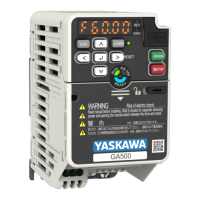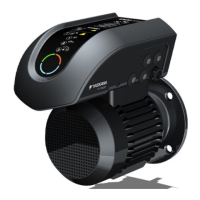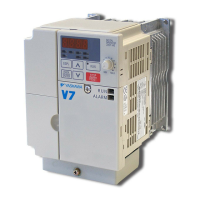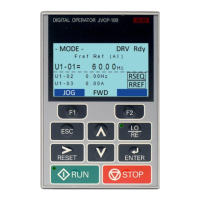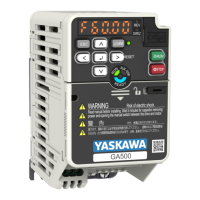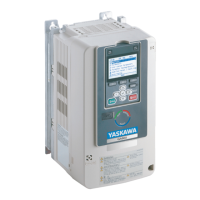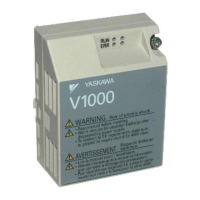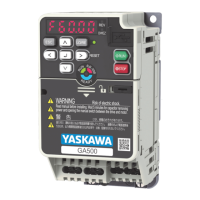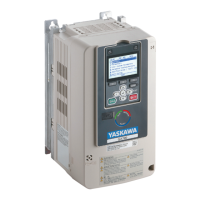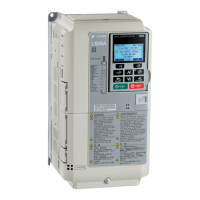Troubleshooting
6
6.5 Faults
YASKAWA SIEPYAIH6B01A HV600 AC Drive Bypass Technical Reference 489
Code Name Causes Possible Solutions
oH1 Heatsink Overheat
The ambient temperature is high and the heatsink
temperature of the drive is more than the oH1
detection level.
• Measure the ambient temperature.
• Increase the airflow in the control panel.
• Install a cooling device (cooling fan or air conditioner) to lower
the ambient temperature.
• Remove objects near the drive that are producing too much heat.
The load is too heavy. • Measure the output current.
• Decrease the load.
• Decrease the value set in C6-02 [Carrier Frequency Selection].
Note:
• The drive detects this fault if the heatsink temperature of the drive is more than the oH1 detection level. o2-04 [Drive Model (KVA) Selection] determines the oH1 detection level.
• Do a Fault Reset to clear the fault.
• L5-08 [Fault Reset Enable Select Grp2] disables the Auto Restart function.
Code Name Causes Possible Solutions
oH3 Motor Overheat (PTC Input)
The thermistor wiring that detects motor temperature
is defective.
Correct wiring errors.
A fault occurred on the machine.
Example: The machine is locked.
Examine the machine and remove the cause of the fault
The motor has overheated. • Check the load level, acceleration/deceleration time, and motor
start/stop frequency (cycle time).
• Decrease the load.
• Increase the values set in C1-01 to C1-04 [Acceleration/
Deceleration Times].
• Set E2-01 [Motor Rated Current (FLA)] correctly to the value
specified by the motor nameplate.
• Make sure that the motor cooling system is operating correctly,
and repair or replace it if it is damaged.
• Adjust E1-04 to E1-10 [V/f Pattern Parameters]. Decrease the
values set in E1-08 [Mid Point A Voltage] and E1-10 [Minimum
Output Voltage].
Note:
If the values set in E1-08 and E1-10 are too low, the overload
tolerance will decrease at low speeds.
Note:
• When H3-02 or H3-10 = E [MFAI Function Selection = Motor Temperature (PTC Input)], the drive detects this fault if the motor overheat signal entered to analog input terminals
A1 or A2 is more than the alarm detection level.
• Do a Fault Reset to clear the fault.
• If the drive detects this fault, it will operate the motor as specified by the Stopping Method set in L1-03 [Motor Thermistor oH Alarm Select].
Code Name Causes Possible Solutions
oH4 Motor Overheat Fault (PTC Input)
The motor has overheated. • Check the load level, acceleration/deceleration time, and motor
start/stop frequency (cycle time).
• Decrease the load.
• Increase the values set in C1-01 to C1-04 [Acceleration/
Deceleration Times].
• Set E2-01 [Motor Rated Current (FLA)] correctly to the value
specified by the motor nameplate.
• Make sure that the motor cooling system is operating correctly,
and repair or replace it if it is damaged.
• Adjust E1-04 to E1-10 [V/f Pattern Parameters]. Decrease the
values set in E1-08 [Mid Point A Voltage] and E1-10 [Minimum
Output Voltage].
Note:
If E1-08 and E1-10 are set too low, the overload tolerance will
decrease at low speeds.
Note:
• The drive detects this fault if the motor overheat signal that was entered to an analog input terminals A1or A2 is more than the alarm detection level. (If H3-02 or H3-10= E [MFAI
Function Select = Motor Temperature (PTC Input)] was set.)
• Do a Fault Reset to clear the fault.
Code Name Causes Possible Solutions
oL1 Motor Overload
The load is too heavy. Decrease the load.
Note:
Reset oL1 when U4-16 [Motor oL1 Level] < 100.
The acceleration/deceleration times or cycle times are
too short.
• Examine the acceleration/deceleration times and the motor start/
stop frequencies (cycle times).
• Increase the values set in C1-01 to C1-04 [Acceleration/
Deceleration Times].
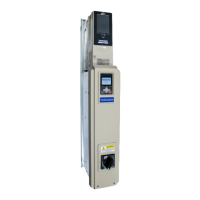
